DASAN Zhone Solutions 242X GPON ONT User Manual zNID 24xx Hardware Installation Guide
Zhone Technologies, Inc. GPON ONT zNID 24xx Hardware Installation Guide
Manual

Zhone zNID 24xx Series
Hardware Installation Guide
For software version 2.4
August 2011
Document Part Number: 830-03747-01
2zNID Hardware Installation Guide
Zhone Technologies
@Zhone Way
7195 Oakport Street
Oakland, CA 94621
USA
510.777.7000
www.zhone.com
info@zhone.com
COPYRIGHT C2000-2011 Zhone Technologies, Inc. and its licensors. All rights reserved.
This publication is protected by copyright law. No part of this publication may be copied or distributed, transmitted, transcribed,
stored in a retrieval system, or translated into any human or computer language in any form or by any means, electronic,
mechanical, magnetic, manual or otherwise, or disclosed to third parties without the express written permission from Zhone
Technologies, Inc.
Bitstorm, EtherXtend, EZ Touch, IMACS, MALC, MXK, Raptor, SLMS, Z-Edge, Zhone, ZMS, zNID and the Zhone logo are
trademarks of Zhone Technologies, Inc.
Zhone Technologies makes no representation or warranties with respect to the contents hereof and specifically disclaims any
implied warranties of merchantability, non infringement, or fitness for a particular purpose.
Further, Zhone Technologies reserves the right to revise this publication and to make changes from time to time in the contents
hereof without obligation of Zhone Technologies to notify any person of such revision or changes.

zNID Hardware Installation Guide 3
TABLE OF CONTENTS
Style and notation conventions..............................................................................5
Typographical conventions.......................................................................................6
Related documentation.............................................................................................6
Acronyms......................................................................................................................7
Contacting Global Service and Support...............................................................9
FCC Statement ..........................................................................................................10
CE..................................................................................................................................10
Important Safety Instructions................................................................................12
Laser Safety Instructions.........................................................................................12
General Instructions................................................................................................13
Chapter 1 zNID 24xx Series....................................................................................................15
Overview ....................................................................................................................15
zNID 24xx series components ................................................................................17
zNID 24xx series features.......................................................................................19
zNID 24xx models..................................................................................................20
GPON models...................................................................................................21
Gigabit Ethernet models...................................................................................21
zNID 24xx series specifications..............................................................................22
Interface comparison of zNID 24xx models...........................................................25
zNID 24xx series dimensions................................................................................26
zNID 24xx series LEDs............................................................................................27
GPON......................................................................................................................27
Logging in to the 24xx series zNID......................................................................29
Table of Contents
4zNID Hardware Installation Guide
Chapter 2 zNID 24xx Installation..........................................................................................31
Install the zNID ..........................................................................................................31
Installation precautions...........................................................................................33
Mount the zNID......................................................................................................33
Wall mount with fiber tray...............................................................................34
Wall mount without fiber tray..........................................................................36
Desktop with fiber tray.....................................................................................37
Manage the optical cable .......................................................................................38
Fiber handling...................................................................................................38
Testing optical power.......................................................................................38
Optical fiber cable placement in the zNID fiber tray..............................................39
Connect to network.................................................................................................40
Connect power ........................................................................................................41
Connecting phone terminals ...................................................................................42
Connecting Ethernet ports.......................................................................................43
Connecting coaxial port..........................................................................................44
Connecting USB port..............................................................................................45
Complete the zNID installation ..............................................................................45
Index......................................................................................................................................................47
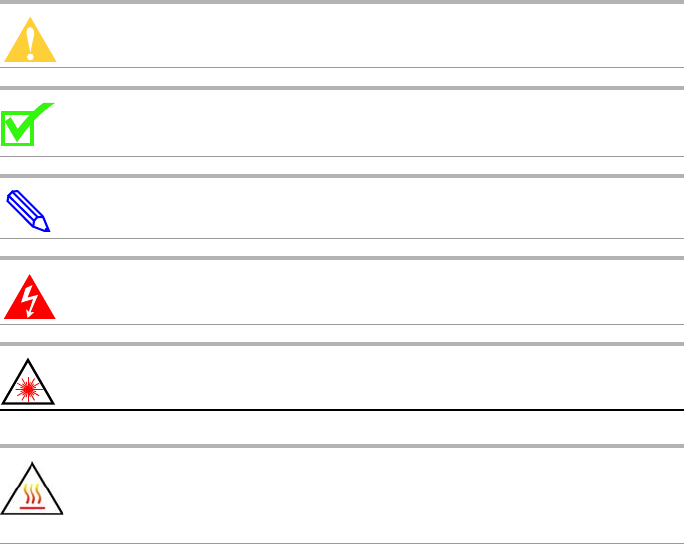
zNID Hardware Installation Guide 5
ABOUT THIS GUIDE
This guide is intended for use by installation technicians, system
administrators, or network administrators. It explains how to install the zNID
24xx series enclosure, electronics and cabling.
Style and notation conventions
This document uses the following conventions to alert users to information
that is instructional, warns of potential damage to system equipment or data,
and warns of potential injury or death. Carefully read and follow the
instructions included in this document.
Caution: A caution alerts users to conditions or actions that could
damage equipment or data.
Note: A note provides important supplemental or amplified
information.
Tip: A tip provides additional information that enables users to more
readily complete their tasks.
WARNING! A warning alerts users to conditions or actions that
could lead to injury or death.
WARNING! A warning alerts users to conditions or actions that
could lead to injury caused by a laser.
WARNING! This icon warns the user that metal surfaces can
become hot to touch. Avoid contact or use caution when touching
these surfaces.
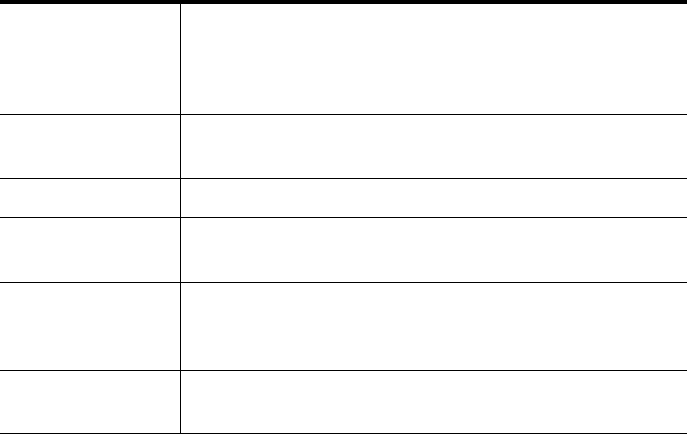
About This Guide
6zNID Hardware Installation Guide
Typographical conventions
The following typographical styles are used in this guide to represent specific
types of information.
Related documentation
Refer to the following publication for additional information:
•zNID Quick Installation Instructions for the zNID you are installing.
These instructions are shipped with the zNID, but are also available on
the Zhone website.
•zNID 24xx Configuration Guide — explains how to use the zNID web
interface and describes the system commands and parameters.
Refer to the release notes for software installation information and for
changes in features and functionality of the product (if any).
Bold Used for names of buttons, dialog boxes, icons, menus,
profiles when placed in body text, and property pages (or
sheets). Also used for commands, options, parameters in
body text, and user input in body text.
Fixed Used in code examples for computer output, file names, path
names, and the contents of online files or directories.
Fixed Bold Used in code examples for text typed by users.
Fixed Bold
Italic
Used in code examples for variable text typed by users.
Italic Used for book titles, chapter titles, file path names, notes in
body text requiring special attention, section titles,
emphasized terms, and variables.
PLAIN UPPER
CASE Used for environment variables.

Acronyms
zNID Hardware Installation Guide 7
Acronyms
The following acronyms are related to Zhone products and may appear
throughout this manual:
Table 1: Acronyms and their descriptions
Acronym Description
Active E Active Ethernet, also known as Gigabit Ethernet
APC Angled physical contact (for fiber connector)
Coax Coaxial cable
CNI Comfort Noise Insertion
CPE Consumer Premises Equipment
DHCP server Dynamic host configuration protocol server
EZ touch™ Zhone’s implementation for managing CPEs and zNIDs
GigE Gigabit Ethernet
GPON Gigabit passive optical network
HPNA Home phone line networking alliance
IPTV Internet protocol TV
LED Light-emitting diode
MALC Multi-access line concentrator
MDU Multiple Dwelling Unit
MIB Management information bases
MoCA Multimedia over Coax Alliance
OLT Optical Line Terminator
ONT Optical Network Terminator
ONU Optical Network Unit
PoE Power over Ethernet
PPPoE Point-to-point protocol over Ethernet
QoS Quality of service
RF Radio Frequency
RFoG Radio Frequency over Glass
SC adaptor Subscriber connector adaptor
SIP Session initiation protocol
SNMP Simple network management protocol
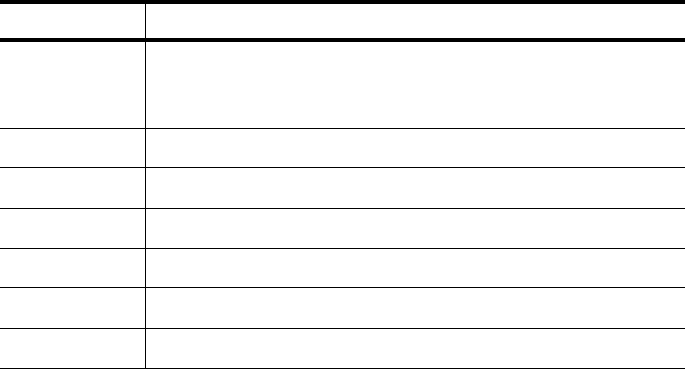
About This Guide
8zNID Hardware Installation Guide
T1/E1 T1 is Trunk line 1 (or DS 1, digital signal level 1). E1 is the
European equivalent, though there are a number of differences
between the North American T1 and the European E1.
UPC Ultra physical contact (for fiber connector)
Wi-Fi Wireless local area network (trademark of Wi-Fi alliance)
VAD Voice Activity Detection
VOIP Voice over IP
zNID Zhone Network Interface Device
ZMS Zhone Management System
Table 1: Acronyms and their descriptions (Continued)
Acronym Description
Contacting Global Service and Support
zNID Hardware Installation Guide 9
Contacting Global Service and Support
Support for this product is provided by your Internet service provider
About This Guide
10 zNID Hardware Installation Guide
FCC Statement
This equipment has been tested and found to comply with the limits for a
Class B digital device, pursuant to Part 15 of the FCC Rules. These limits are
designed to provide reasonable protection against harmful interference in a
residential installation. This equipment generates, uses and can radiate radio
frequency energy and, if not installed and used in accordance with the
instructions, may cause harmful interference to radio communications.
However, there is no guarantee that interference will not occur in a particular
installation. If this equipment does cause harmful interference to radio or
television reception, which can be determined by turning the equipment off
and on, the user is encouraged to try to correct the interference by one of the
following measures:
•Reorient or relocate the receiving antenna.
•Increase the separation between the equipment and receiver.
•Connect the equipment into an outlet on a circuit different from that to
which the receiver is connected.
•Consult the dealer or an experienced radio/TV technician for help.
FCC Caution: Any changes or modifications not expressly approved by the
party responsible for compliance could void the user's authority to operate this
equipment.
This device complies with Part 15 of the FCC Rules. Operation is subject to
the following two conditions: (1) This device may not cause harmful
interference, and (2) this device must accept any interference received,
including interference that may cause undesired operation.
CE
For the following equipment:
•ZNID-GPON-2402-XXX
•ZNID-GPON-2403-XXX
•ZNID-GPON-2424-XXX
•ZNID-GPON-2425-XXX
•ZNID-GPON-2426-XXX
•ZNID-GPON-2427-XXX
The xxx suffix, 2-3 alphanumeric characters identify the sales region or
specific customer with customized LOGO or software.
Is herewith confirmed to comply with the requirements setout in the Council
Directive on the Approximation of the Laws of the Member States relating to
Electromagnetic Compatibility (2004/108/EC), Low-voltageDirective (2006/
CE
zNID Hardware Installation Guide 11
95/EC) and R&TTE (1999/5/EC).The equipment has passed The test was
performed according to thefollowing European standards:
•ETSI EN 301 489-17 V2.1.1: 2009
•ETSI EN 301 489-1 V1.8.1: 2008
•ETSI EN 300 328 V1.7.1: 2006
•EN 62311: 2008
•EN 60950-1: 2006+A11 2009
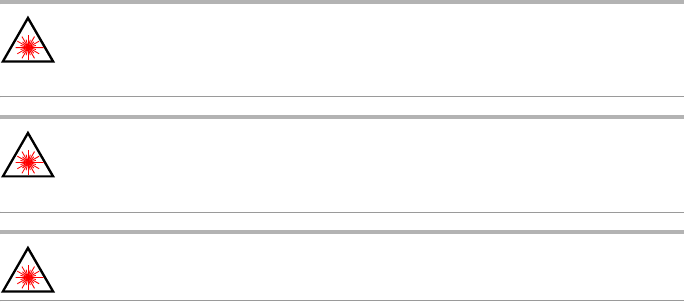
About This Guide
12 zNID Hardware Installation Guide
Important Safety Instructions
Read and follow all warning notices and instructions marked on the product
and included in the manual.
Laser Safety Instructions
Zhone equipment and associated optical test sets use laser sources that emit
light energy into fiber cables. This energy is within the red (visible) and
infrared (invisible) regions of the electromagnetic spectrum.
Laser products are subject to federal and state or provincial regulations, and
local practices. Regulation 21 CFR 1040 of the U.S. Bureau of Radiological
Health requires manufacturers to certify each laser product as Class I, II, III,
or IV, depending upon the characteristics of the laser radiation emitted. In
terms of health and safety, Class I products present the least hazard (none at
all), while Class IV products present the greatest hazard.
Although Zhone optical products have a Class I certification, hazardous
exposure to laser radiation can occur when fibers connecting system
components are disconnected or broken.
Certain procedures carried out during testing require the handling of optical
fibers without dust caps and therefore increase the risk of exposure. Exposure
to either visible or invisible laser light can damage your eyes under certain
conditions.
Read and observe the following precautions to decrease the risk of exposure
to laser radiation.
WARNING! Risk of eye damage. At all times, when handling
optical fibers, follow the safety procedures recommended by your
company.
WARNING! Avoid direct exposure to fiber ends or optical
connector ends. Laser radiation may be present and can damage
your eyes.
WARNING! Never look into an active optical fiber or an optical
fiber connector opening of an active or powered-up unit.
Note: When working with optical fibers, take these precautions:
•Wear safety glasses when installing optical fibers.
•Clean hands after handling optical fibers. Small pieces of glass are not
always visible and can cause eye damage. Get medical assistance
immediately for any glass that comes into eye contact.
Important Safety Instructions
zNID Hardware Installation Guide 13
•Prevent direct exposure to optical fiber ends or optical connector ends
where laser signals are directly accessed. Do not handle pieces of optical
fiber with fingers. Use tweezers or adhesive tape to lift and discard any
loose optical fiber ends.
•Wear rubber gloves to clean optical connectors. The gloves prevent direct
contact with the isopropyl alcohol and prevent contamination of the
ferrules with skin oils.
•Place all optical fiber clippings in a plastic container provided for that purpose.
•Handle optical fibers with caution. Place the optical fibers in a safe
location during installation.
•Follow the manufacturer instructions when using an optical test set. Incorrect
calibration or control settings can create hazardous levels of radiation.
General Instructions
Other precautions to take before installing or servicing the product are as follows:
•Never install telephone wiring during a lightning storm.
•Never touch uninsulated telephone wires or terminals unless the
telephone line has first been disconnected at the network interface.
•Use caution when installing or modifying telephone lines.
•Only authorized service technicians can service this
product.Unauthorized service to this product can cause exposure to
dangerous high-voltage points or other risks and may result in injury or
damage to the unit and void all warranties.
•Special cables, which may be required by the regulatory inspection
authority for the installation site, are the responsibility of the buyer.
•When installed in the final configuration, the product must comply with
the applicable Safety Standards and regulatory requirements of the
country in which it is installed. If necessary, consult with the appropriate
regulatory agencies and inspection authorities to ensure compliance.
•Install the zNID in accordance with national and local electric codes in order
to meet all applicable requirements. Consult a qualified electrical consultant.
About This Guide
14 zNID Hardware Installation Guide

zNID Hardware Installation Guide 15
ZNID 24XX SERIES
This chapter describes the 24xx series of zNIDs. It includes the following
sections:
•Overview, page 15
•zNID 24xx series features, page 19
•zNID 24xx models, page 20
•zNID 24xx series specifications, page 22
•zNID 24xx series dimensions, page 26
•zNID 24xx series LEDs, page 27
•Logging in to the 24xx series zNID, page 29
Overview
The zNID 24xx Series (Zhone Network Interface Device) is a family of
indoor residential GPON ONTs which are standards based Consumer
Premises Equipment (CPE) designed for advanced triple-play deployments.
The indoor models in Zhone's zNID product line of ONT's provide a lower
cost alternative to outdoor ONT solutions. The small package contains many
features including QoS, VoIP, and multicast video support. The zNID ONT is
only one component in the PON network. Zhone provides the entire FTTx
solution to our customers including the OLT, splitters, cabinets, and the ONT.
The 24xx indoor ONT is designed for high performance applications.
Depending on model hardware features include 10/100/1000Mbps LAN Ports
and POTS Voice FXS ports, RF video, WiFi and USB in a compact enclosure
for indoor use. zNID 24xx Series units may be installed as a desktop or, wall
mounted and is powered via an AC Adaptor.
The zNID 24xx Series are ideal for triple-play service deployments in
Fiber-to-the-Home/Premise application. Industry standard SIP and MGCP
voice signaling provides reliable voice services while Zhone's experience
with packet voice ensures interoperability and support with a large number of
soft switches.
All 24xx series Single Family Unit (SFU) ONTs provide the same voice
features found on the 42xx series of outdoor residential ONTs and 9xxx series
of outdoor Multiple Dwelling Unit (MDU) ONTs. SIP-PLAR signaling is
zNID 24xx Series
16 zNID Hardware Installation Guide
supported for connection via Zhone's Voice Gateway to traditional Class 5
TDM switches, while both MGCP and SIP are supported for direct connection
to a VoIP Softswitch. This flexibility allows Zhone's 42xx, 9xxx and 24xx
Series ONTs to work in nearly all Telco networks, with interoperability
support for a broad array of Softswitches.
The Ethernet ports can be separated into different services allowing the
configuration of dedicated ports for IP video and data.
Compliant with standard OMCI definition, 2424 is manageable at remote side
and supports the full range FCAPS functions including supervision,
monitoring and maintenance.
Zhone provides THE complete PON solution: ONT, OLT, splitter, EDFA, RF
Transmitters, and cabinet solutions are available from Zhone because our
customers want to buy a complete and fully tested solution from one trusted
source.
The zNID 24xx series may be managed by
•EZ Touch (Zhone’s CPE and zNID management application)
•Zhone Management System (ZMS)
•Web (HTTP)
•Command Line Interface (CLI/Telnet/SSH)
More information about managment capabilities see the zNID Administrator
and Operators Guide.
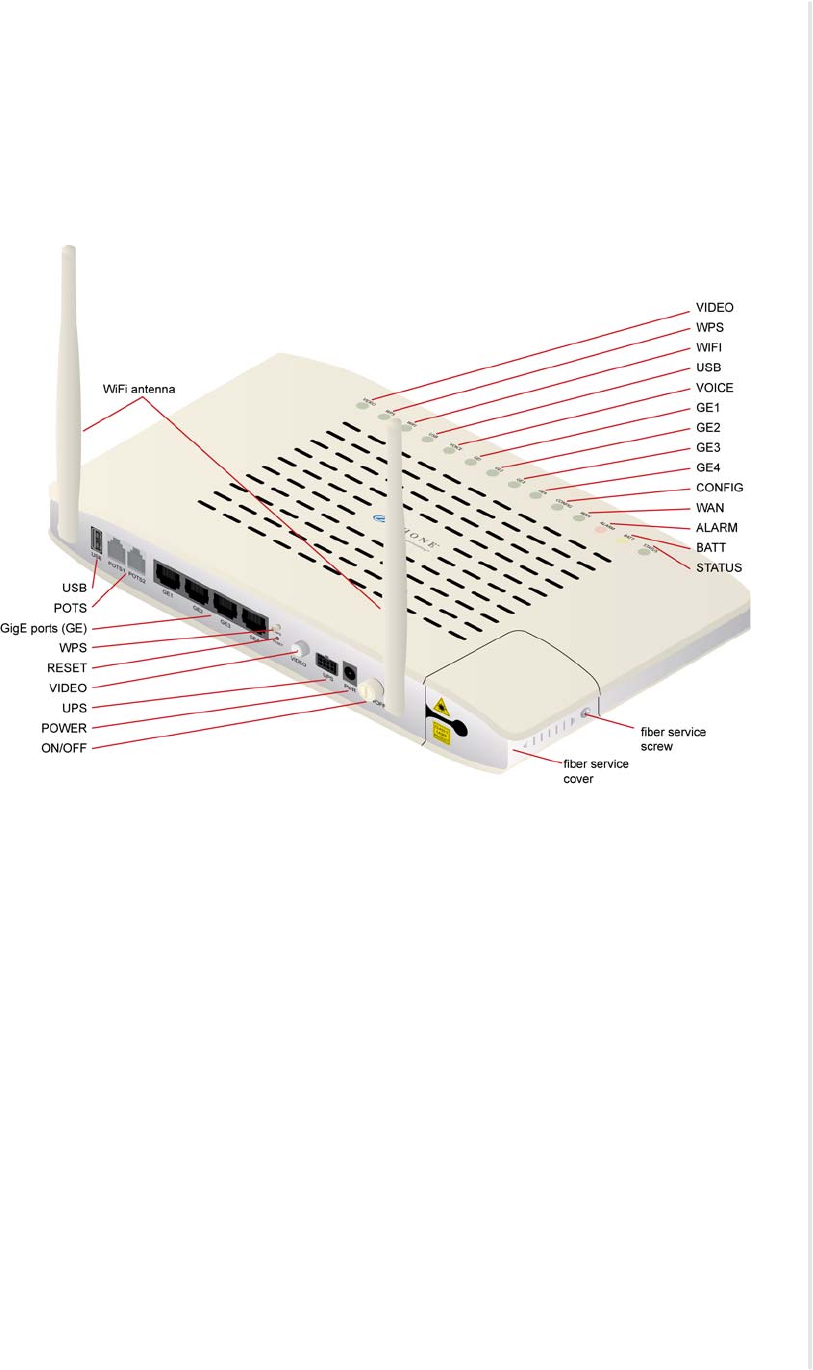
Overview
zNID Hardware Installation Guide 17
zNID 24xx series components
The zNID 24xx series indoor ONTs provide a variety of interfaces for triple
play deployments. These indoor units may be mounted to a wall or placed on
a desktop.
Figure 1: The interfaces, displays and buttons for the zNID 24xx
Depending upon the zNID model selected, the interfaces on the zNID can
include:
•Two or four Gigabit Ethernet RJ45 ports
•Two phone ports (POTS)
•WiFi antennae
•RF video
•USB
•Connection for uninterruptable power supply (UPS)
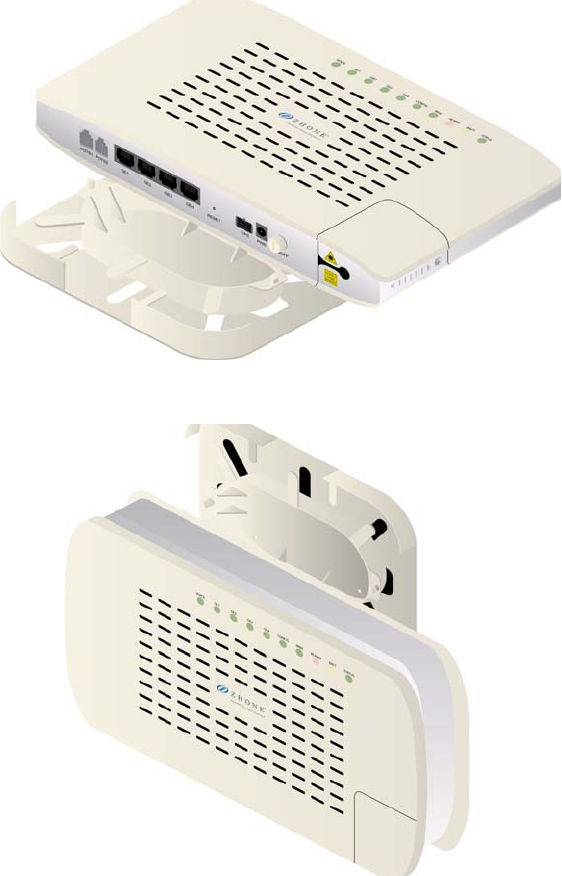
zNID 24xx Series
18 zNID Hardware Installation Guide
Figure 2: The zNID 24xx series attaches to a fiber tray base
Figure 3: The unit may also be wall mounted, with or without a fiber tray

zNID 24xx series features
zNID Hardware Installation Guide 19
zNID 24xx series features
Under ideal circumstances, GPON can reach up to 20 or 30 km, however the
practical limit is 12 km (about eight miles). Reach is dependent on the
configuration of the optical distribution network (ODN).
All 24xx series ONTs are designed for indoor use.
The 24xx series of zNIDs share a common SW architecture with the 42xx and
9xxx series of zNIDs, including the same intuitive Web interface and
command line interface. The zNID is also managed by the Zhone Network
Management System (ZMS),using SNMP. Software upgrades and
configuration backups can be handled automatically by the ZMS using the EZ
Touch management feature.
This section covers:
•zNID 24xx models
•zNID 24xx series specifications
•zNID 24xx series dimensions
The zNID enables service providers to provide voice, data, and video services
along with advanced IP and data support.
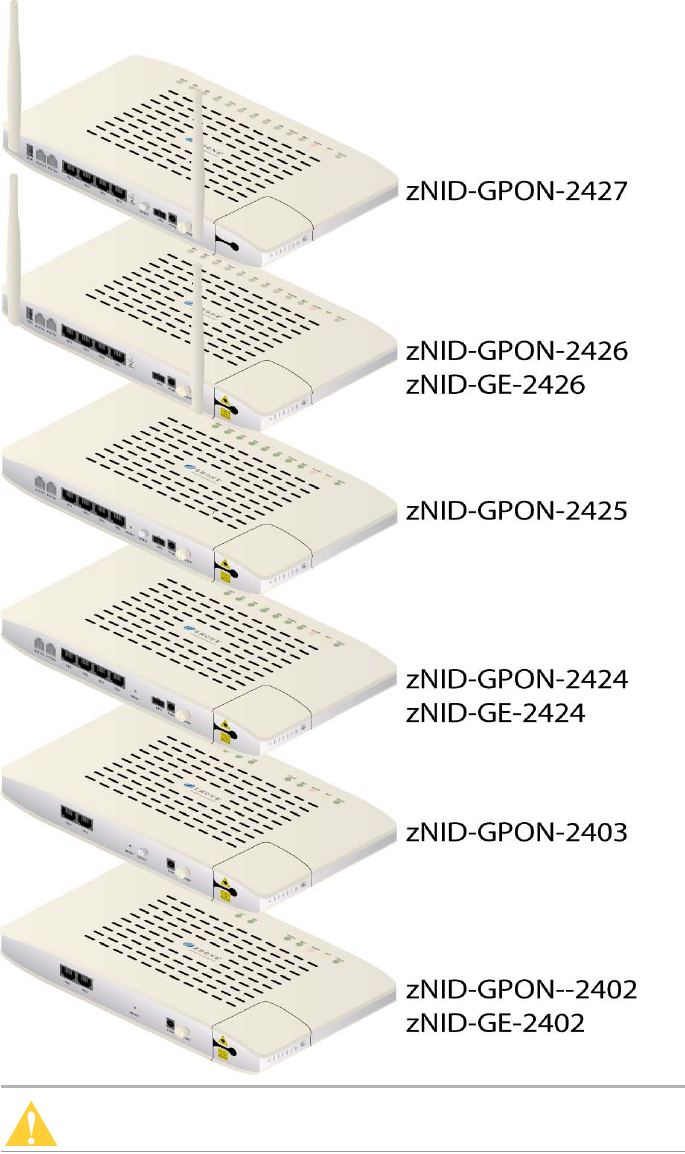
zNID 24xx Series
20 zNID Hardware Installation Guide
zNID 24xx models
Figure 4: zNID 24xx models
Caution: To ensure adequate ventilation, nothing should be placed
on the top of the zNID 24xx. zNID 24xx units should not be stacked.

zNID 24xx models
zNID Hardware Installation Guide 21
GPON models
The zNID series GPON models have the following interfaces:
Gigabit Ethernet models
The zNID series Gigabit Ethernet models have the following interfaces:
Model Description
zNID-GPON-2402 GPON Uplink, 2 GigE
zNID-GPON-2403 GPON Uplink, 2 GigE, RFV
zNID-GPON-2424 GPON Uplink, 2 POTS, 4 GigE
zNID-GPON-2425 GPON Uplink, 2 POTS, 4 GigE, RFV
zNID-GPON-2426 GPON Uplink, 2 POTS, 4 GigE, WiFi, USB
zNID-GPON-2427 GPON Uplink, 2 POTS, 4 GigE, WiFi, RFV, USB
Model Description
zNID-GE-2402 GE Uplink, 2 GigE
zNID-GE-2424 GE Uplink, 2 POTS, 4 GigE
zNID-GE-2426 GE Uplink, 2 POTS, 4 GigE, WiFi, USB

zNID 24xx Series
22 zNID Hardware Installation Guide
zNID 24xx series specifications
The possible interfaces and number of interfaces depend on the specific
model, see zNID 24xx models on page 20 for a list of models and their
interfaces.
Table 2: zNID 24xx common specifications
Specifications Values
Dimensions: 1.18 in (30 mm) high x 10.04 in (255 mm) wide x 5.91 in (150 mm) deep
height does not including feet
Weight: 500 g (1.1 lb.)
Operating temperature: 00Cto+40
0C (320F to +104F)
Storage temperature -200Cto+85
0C (-40F to +185F)
Power Input: 110/240V AC Adaptor (12 VDC)
Power Consumption: 8-12W
Dying Gasp Support
Interfaces Uplinks:
•GPON: SC/APC connector
–1.244Gbps Burst Mode Upstream Transmitter (1310nm)
–2.488Gbps Downstream Receiver (1490nm)
Customer facing interfaces (Depends on model):
•POTS interfaces (RJ11)
•Gig E interfaces (RJ45 - 10/100/1000Base-T Ethernet)
Host port interface:
•USB craft port (standard type A USB connector) zNID 2426 and 2427 only
WIFI interface:
•Dual 802.11b/g/n WiFi WiFi antennae zNID 2426 and 2427 only
Coaxial interface:
•RF video overlay zNID 2403, 2425 and 2427 only
Standards Support •ITU-T G.984 compliant

zNID 24xx models
zNID Hardware Installation Guide 23
Protocol Support •GPON uplink
–ITU-T G.984 (GPON)
–Multiple T-CONTS per device
–Multiple GEM Ports per device
–
1:1 mapping of GEM ports into T-CONTS with priority queue based scheduling
–Activation with automatic discovered SN and password in conformance
with ITU-T G.984.3
–AES-128 Decryption with key generation and switching
–FEC (Forward Error Correction)
–802.1p mapper service profile on U/S
–
Mapping of GEM Ports into a T-CONT with priority queues based scheduling
–Support for Multicast GEM Port
•Ethernet/IP
–Bridging and switching (802.1D / 802.1 Q)
–Eight traffic classes with 802.1p
–802.3n flow control
–MAC address entries
For OMCI-configured traffic flows, no limit (no bridge table)
For Bridged VLANs
, configured via Web UI or CLI in RG Mode, 4096 bridge
table entries are supported. (only the most recent 100 entries are displayed).
–VLAN tagging / untagging
–VLAN stacking (Q-in-Q)
–MAC limiting
–802.1x Ethernet Authentication
–PPPoE client
•DHCP server, DHCP client
•FTP, TFTP
•Telnet
•HTTP
•SSH
•SNMP
•NAT
•QoS
–802.1P/Q priorization
–Diffserv (RFC2474, RFC2475)
–Traffic shaping – bandwidth management and rate limiting
•Firewall and Security
Table 2: zNID 24xx common specifications (Continued)
Specifications Values

zNID 24xx Series
24 zNID Hardware Installation Guide
POTS (Voice) Support •SIP (RFC 3261)
•SIP-PLAR
•MGCP
•5 REN per line, balanced Ring at 60V RMS, DTMF dialing
•Multiple voice codec: G.711 (u/a-law), G.726, G.729 (A and B)
•Echo Canceling, Voice Activity Detection (VAD), Comfort Noise Insertion
(CNI)
•Various CLASS services — Caller ID, Call Waiting, Call Forwarding, Call
Transfer, etc.
•T.30 and T.38 Fax
•G.711 fallback for FAX
•Pulse metering
Wireless (WiFi) Support •2x2 MIMO
•Antenna: 5dBi
•25dBM EIRP (316mW) Maximum Tx Power
•max number of subscribers: 16 per SSID
•SSID support: 4
•1:1 mapping of SSIDs to VLANs
•WEP, WPA-PSK, WPA2-PSK (AES, TKIP)
•802.1x
•64 bit and 128 bit WEP support
•MAC address filtering
•DDNS
IPTV •IGMP multicast
•IGMP snooping
Management •Zhone Management System
–EZ Touch
–CPE Manager
•OMCI
•Web UI
•Command Line Interface
•SNMP
Table 2: zNID 24xx common specifications (Continued)
Specifications Values

zNID 24xx models
zNID Hardware Installation Guide 25
Interface comparison of zNID 24xx models
Regulatory Compliance •CE
•UL
•FCC Part B
Table 2: zNID 24xx common specifications (Continued)
Specifications Values
Table 3: Feature comparison of GPON model
Model Upstream Interface POTS 10/100/1000 RF Video WiFi USB
zNID-GPON-2402 GPON 0 2
zNID-GE-2402 Gigabit Ethernet 0 2
zNID-GPON-2403 GPON 0 2 X
zNID-GPON-2424 GPON 2 4
zNID-GE-2424 Gigabit Ethernet 2 4
zNID-GPON-2425 GPON 2 4 X
zNID-GPON-2426 GPON 2 4 X X
zNID-GE-2426 Gigabit Ethernet 2 4 X X
zNID-GPON-2427 GPON 2 4 X X X
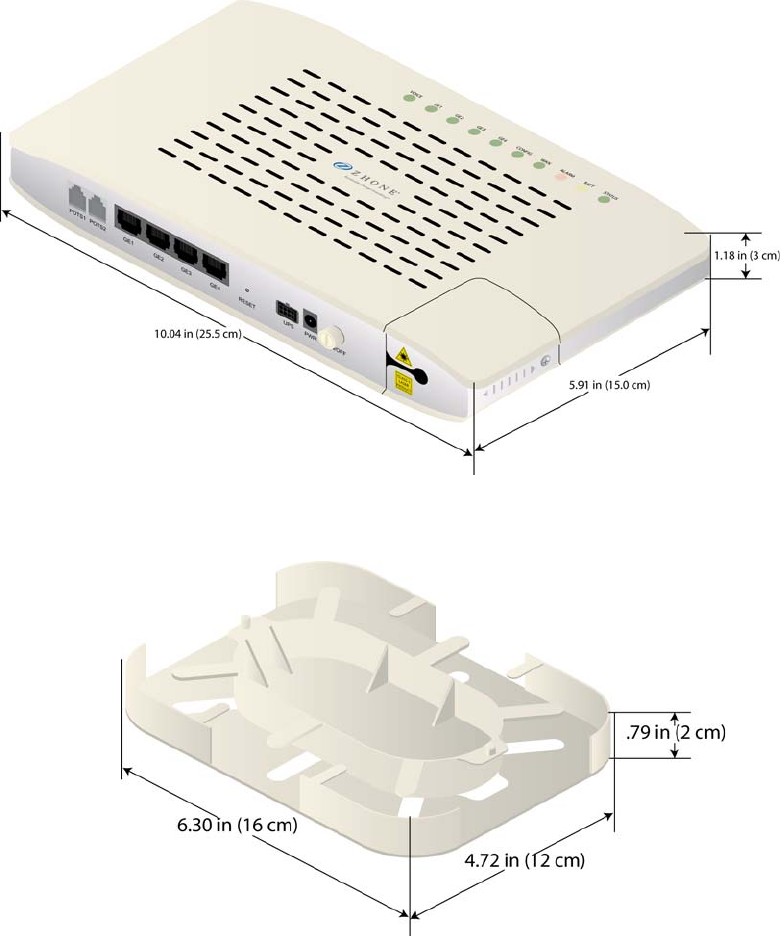
zNID 24xx Series
26 zNID Hardware Installation Guide
zNID 24xx series dimensions
Figure 5: zNID 24xx dimensions
Figure 6: zNID fiber tray dimensions

zNID 24xx series LEDs
zNID Hardware Installation Guide 27
zNID 24xx series LEDs
The LEDs vary depending on the model of zNID. See zNID 24xx models on
page 20 for a complete list of zNID models.
GPON
Figure 7: zNID-GPON-24xx LEDS
Table 4: zNID-GPON-24xx LEDs
LED Name Color Indicates
STATUS Green: Heartbeat
(1 short blink every
5 seconds)
Normal Operation
Green: Rapid blink
(10/sec)
Unit has been reset to Factory
Defaults / is unconfigured
Green: Alternating
fast blinking and
Off (1 second rapid
blink/1 second off)
EZ Touch communications in process
Green: Slow blink
(1/second) Remote Mgt Access (OMCI, SNMP,
HTTP, Telnet, or TR-069)
Green: On Reboot or restart in process
Off Power off
BATT Yellow: On Operating on Battery Power
Yellow: Slow blink
(1/sec) Battery Alarm (Low Battery, Missing,
or Replace)
Off Normal operation on AC power
ALARM Red: On Running on battery
Red: 50% cycle: 1
sec Rapid Blink/
1 sec Off
EZ Touch actions pending -- SW or
Config update required
Off Normal operation on AC power

zNID 24xx Series
28 zNID Hardware Installation Guide
WAN Green: On Ranged successfully
Green: Slow blink
(1/sec) Ranging in progress
Off Not ready for ranging or not
provisioned
CONFIG Green: On OMCI provisioning is complete
Green: Rapid blink
(10/sec) OMCI provisioning is written to
FLASH
Green: Slow blink
(1/sec) OMCI provisioning is in progress
Off No OMCI provisioning
GE1 – GE4 Green: On Ethernet interface link
Green: Flash Data transmitting
Off No link on Ethernet interface
VOICE Green: On Registered successfully
Green: Slow blink
(1/sec) Off hook
Off Registration failed or telephone
service is not provisioned
USB Green: On Connected
Off No power/USB not connected
WIFI Green: On WIFI enabled
Green: Flash Data transmitting
Off WIFI disabled
WPS Green: Long flash Success
Green: Flash In progress
Off WPS disabled
VIDEO Green: On 1550nm signal is normal and RF
video output is enabled
Green: Slow blink
(1/sec) RF video output is enabled, but no
1550nm signal received
Off RF video output is disabled
Table 4: zNID-GPON-24xx LEDs
LED Name Color Indicates
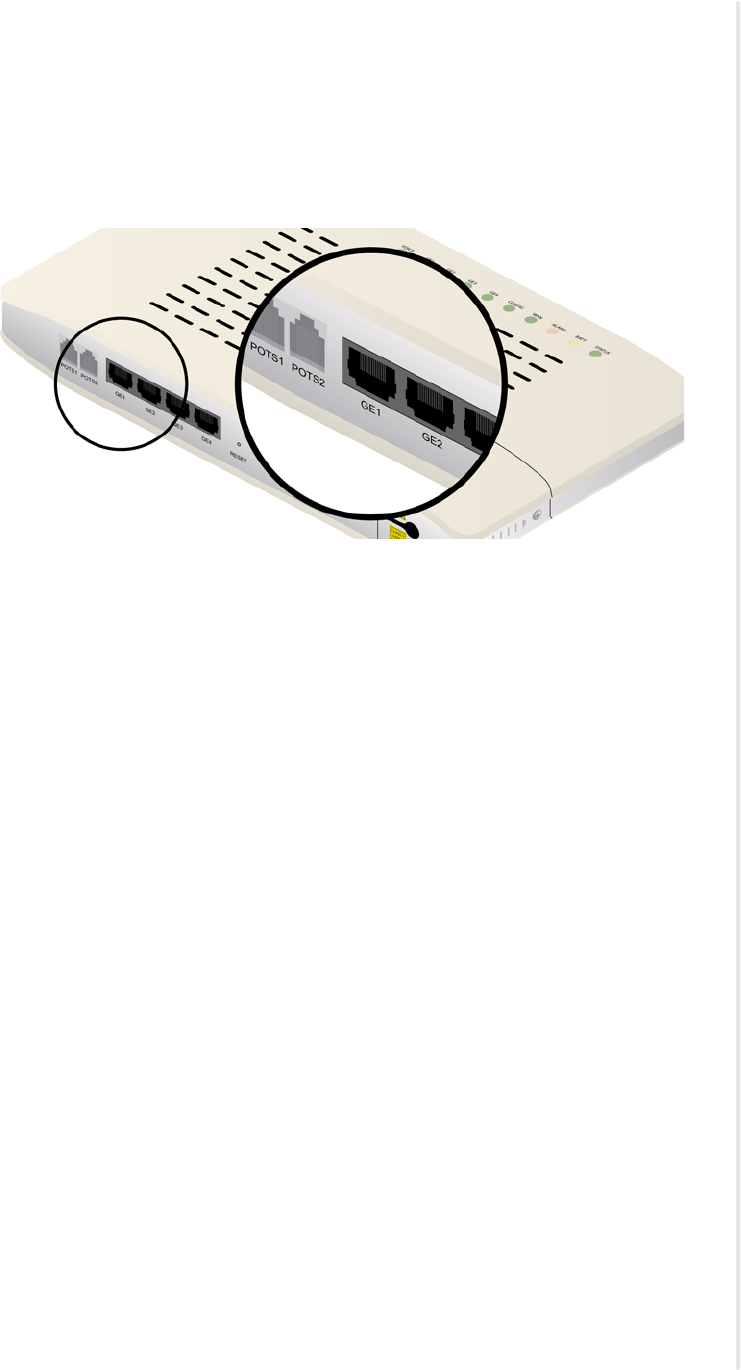
Logging in to the 24xx series zNID
zNID Hardware Installation Guide 29
Logging in to the 24xx series zNID
The zNID 24xx series may be managed from OMCI, Web UI or CLI. This
section describes logging into the zNID locally using the subscriber facing
LAN port, GE1.
Figure 8: Log into GE port 1 to reach the Web UI or CLI on the zNID
To login with a browser:
1Connect an Ethernet cable from your computer to GE1 on the zNID.
2Launch a browser and point it to 192.168.1.1.
3Enter the username and password.
The default username/password is admin/zhone.
To login with a telnet session:
1Connect an Ethernet cable from your computer to GE1 on the zNID
2Launch a telnet session and point it to 192.168.1.1.
3Enter the username and password.
The default username/password is admin/zhone.
zNID 24xx Series
30 zNID Hardware Installation Guide

zNID Hardware Installation Guide 31
ZNID 24XX INSTALLATION
This chapter can be used as separate installation instructions. This chapter
explains how to unpack the zNID 24xx and install the zNID 24xx hardware. It
includes the following sections:
•Install the zNID, page 31
•Overview of zNID 24xx series installation, page 32
Install the zNID
This section describes the procedures for installing the zNID. The overiew
procedure provides options for wall mounting or placing the zNID on a
surface with or without the optional fiber tray.
This section contains the following topics:
•Overview of zNID 24xx series installation on page 32
•Installation precautions on page 33
•Mount the zNID on page 33
–Wall mount with fiber tray on page 34
–Wall mount without fiber tray on page 36
–Desktop with fiber tray on page 37
•Manage the optical cable on page 38
•Fiber handling on page 38
•Testing optical power on page 38
•Optical fiber cable placement in the zNID fiber tray on page 39
•Connect to network on page 40
•Connect power on page 41
•Connecting phone terminals on page 42
•Connecting Ethernet ports on page 43
•Complete the zNID installation on page 45
zNID 24xx Installation
32 zNID Hardware Installation Guide
Overview of zNID 24xx series installation
1Select the location
Ensure that the environment is free of dust and excessive moisture and
has sufficient ventilation.
The zNID may be installed in a vertical or horizontal orientation (wall or
desktop. The zNID should be placed in a clean dry place as is appropriate
for electronic equipment
Installation precautions on page 33
Install the system in reasonable proximity to all equipment or rooms
where the TV or computer reside for straightforward connections.
2Mount the zNID.
Mount the zNID on page 33
3Install service fiber to the zNID.
Connect to network on page 40
4Connect AC power and/or UPS
Connect power on page 41
5Connect the subscriber facing services
aConnect telephone (POTS) service
See Connecting POTS on page 42.
bConnect Ethernet service
See Connect Ethernet ports on page 43.
cConnect Ethernet service
See Connect coaxial port on page 44.
6Complete
Checking the LEDs on page 45

Installation precautions
zNID Hardware Installation Guide 33
Installation precautions
Maximum operating temperature should not exceed the range of 0° C to 40° C
(32° F to 104° F).
Ensure that proper cable grades are used for all system and network
connections. For best results, use the cables and connectors recommended in
this document.
Connect the system to the power supply circuit as described in this document.
Before making fiber connections, be sure that the optical cable fiber tips and
components are clean and free of dust and debris. Follow established cleaning
procedures if required.
Note: Sharp bends in fiber cables create undesirable optical
attenuation or loss. The zNID fiber tray provides fiber spools and
hooks to avoid sharp bends in the fiber cable. A minimum bend radius
of 30 mm (1.2 in) is recommended for stripped fiber.
Mount the zNID
The zNID enclosure can be mounted on a vertical surface or a horizontal
surface (wall or desktop).
•Wall mount with fiber tray on page 34
•Wall mount without fiber tray on page 36
•Desktop with fiber tray on page 37
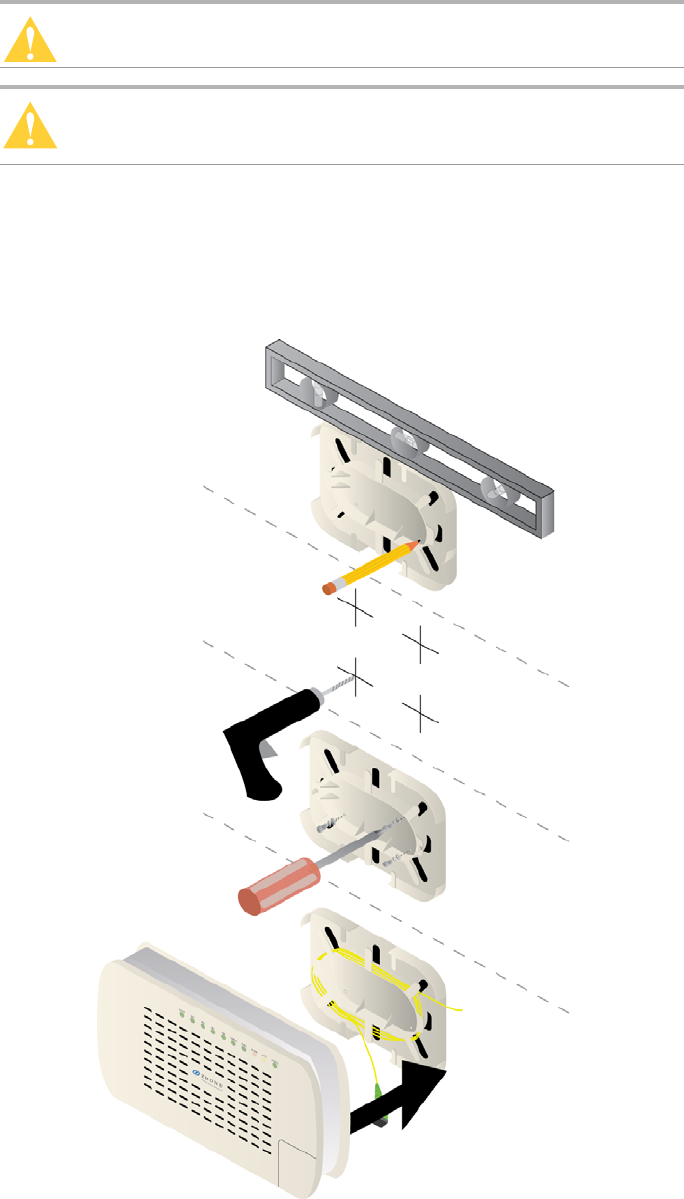
zNID 24xx Installation
34 zNID Hardware Installation Guide
Wall mount with fiber tray
The zNID fiber tray can be mounted on a wall using four screws.
Caution: To prevent damage to the enclosure, use screws
appropriate to the mounting surface.
Caution: Install the zNID fiber tray a proper height from the floor.
Mounting the zNID fiber tray on a wall
To mount the zNID fiber tray on a wall:
Figure 9: Installing the fiber tray on a wall
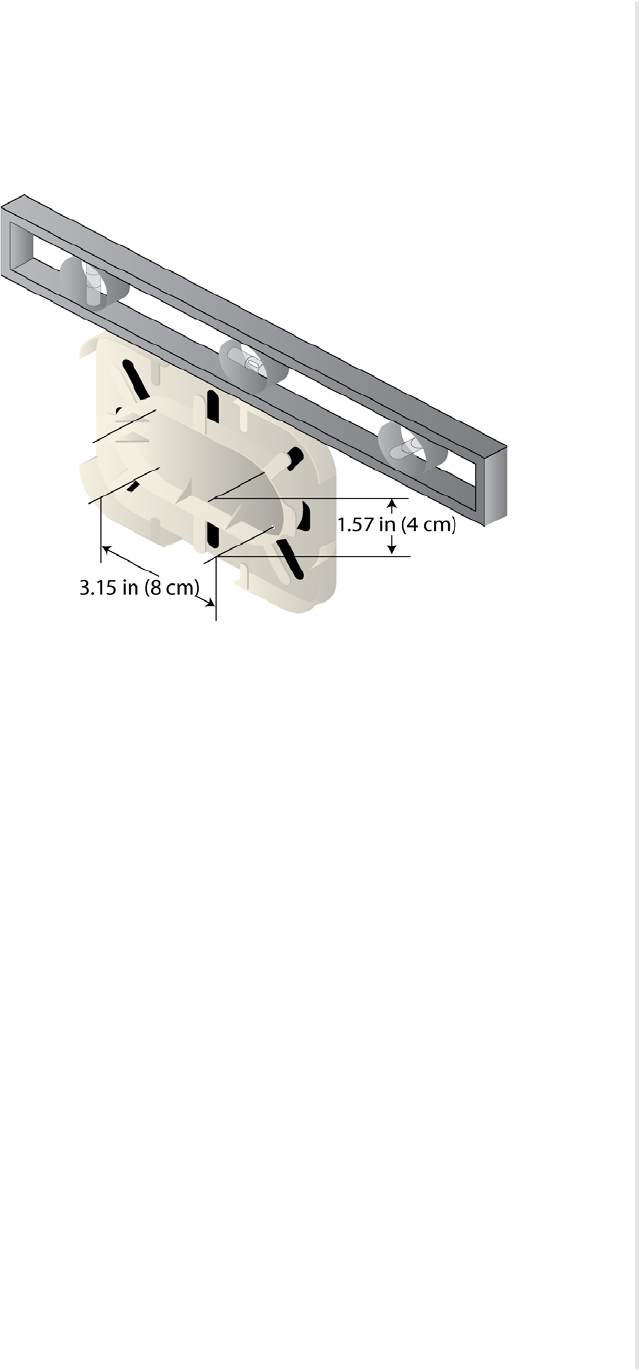
Installation precautions
zNID Hardware Installation Guide 35
1Prepare the surface for mounting.
2Hold the bracket level in the desired location and mark the hole positions.
The holes for the fiber tray are 8 cm apart (about 3.15 inches or a little
less than 3 and 3/16 inches) on the horizontal axis and 4 cm apart (about
1.57 inches or about 1 and 9/16 inches) on the vertical axis.
3Drill the holes.
4Line up the fiber tray with the screw holes and attach the screws.
Use attaching hardware appropriate for the type of surface to which the
unit is mounted (i.e. wood, brick, CB, etc.).
Use shims when necessary to keep the zNID vertical.
5Wind the fiber in the tray.
See Optical fiber cable placement in the zNID fiber tray on page 39
6Put the zNID on the fiber tray.
The wall mount sockets on the zNID fit the two nubs which stick out from
the fiber spool on the fiber tray.
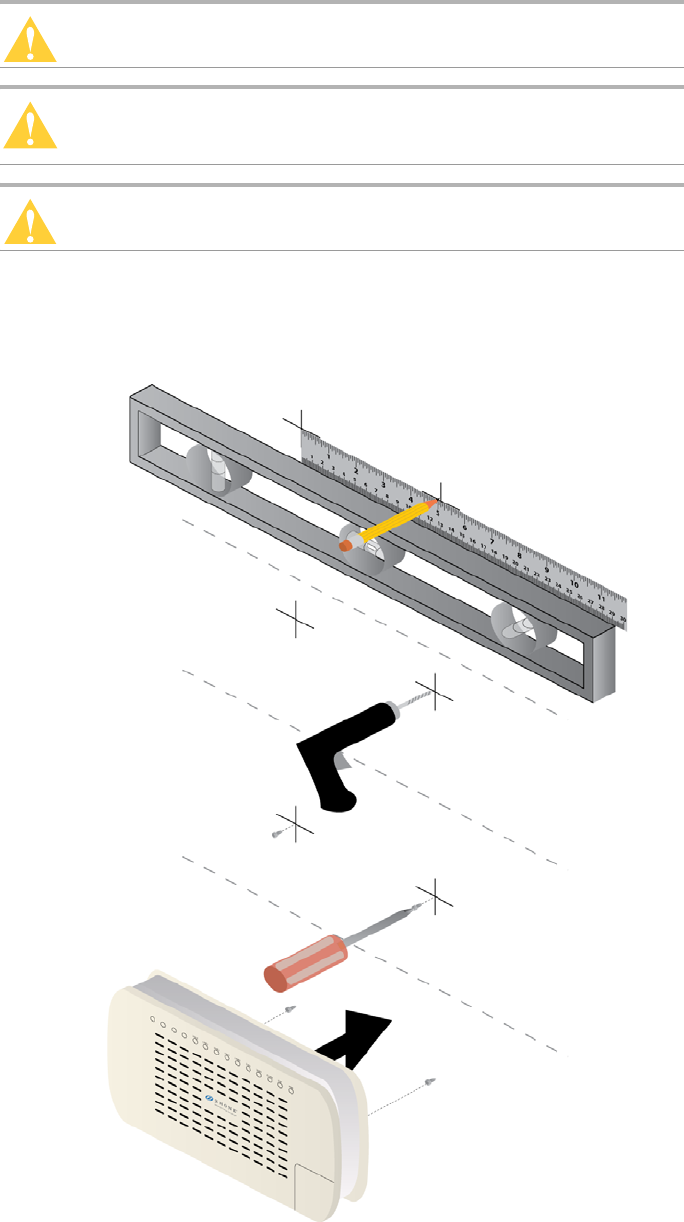
zNID 24xx Installation
36 zNID Hardware Installation Guide
Wall mount without fiber tray
Caution: To prevent damage to the enclosure, use screws
appropriate to the mounting surface.
Caution: Install the zNID fiber tray a proper height from the floor.
Caution: The zNID should always be mounted in a vertical
orientation.
Mounting the zNID on a wall without the fiber tray
Figure 10: Installing the fiber tray on a wall
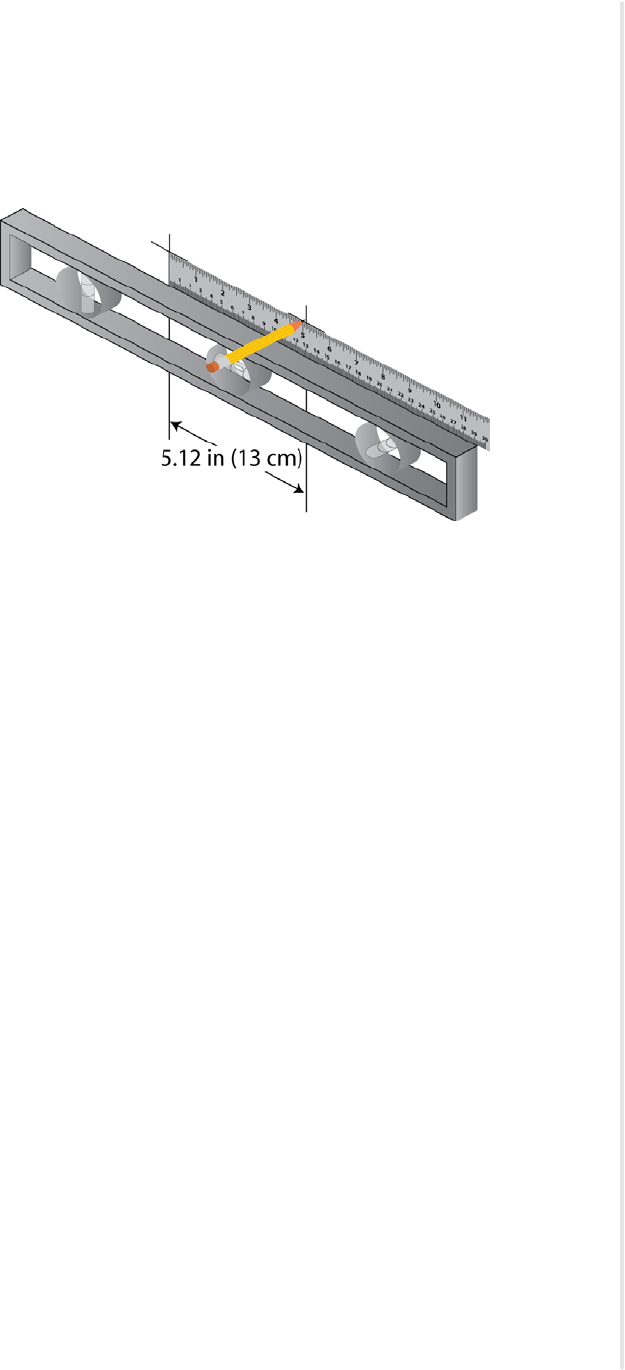
Installation precautions
zNID Hardware Installation Guide 37
To mount the zNID directly on a wall:
1Prepare the surface for mounting.
2Mark the hole positions.
The holes for the fiber tray are 13 cm apart (about 5.12 inches or a little
less than 5 and 1/8 inches) on the horizontal axis.
3Drill the holes.
4Attach the screws.
Use screws appropriate for the type of surface to which the unit is
mounted (i.e. wood, brick, CB, etc.).
5Put the zNID on the screws.
The screws should be leave enough space from being flush with the wall
for the zNID legs to hold the unit firmly against the wall.
Desktop with fiber tray
To mount the zNID fiber tray on a wall:
1Prepare the surface for mounting.
2Wind the fiber in the tray.
See Optical fiber cable placement in the zNID fiber tray on page 39
3Put the zNID on the fiber tray.
The wall mount sockets on the zNID fit the two nubs which stick out from
the fiber spool on the fiber tray.

zNID 24xx Installation
38 zNID Hardware Installation Guide
Manage the optical cable
When making a fiber optic connection, avoid touching the fiber cable ends to
the outside of the mating connector. Touching can contaminate the
connectors.
Fiber handling
Before making any connections, be sure that the optical cable fiber tips and
components are clean and free of dust and debris.
The zNID fiber tray provides fiber spools and hooks to avoid sharp bends in
the fiber cable. A minimum bend radius of 30 mm is recommended for
stripped fiber and larger fiber needs a larger bend radius to guarantee the
specified system performance.
Note: Sharp bends in fiber cables create undesirable optical
attenuation or loss.
Testing optical power
Table 5 specifies how much laser power to expect on the fiber.
Table 5: Optical values for the triplexer
Parameter 1490 nm 1550 nm
Damage Level +5 dBm +5 dBm
Optical Overload -8 dBm +2 dBm
Minimal Optical Signal -28.5 dBm -8 dBm
Mid Range Optical Value -17 dBm -4 dBm

Installation precautions
zNID Hardware Installation Guide 39
Optical fiber cable placement in the zNID fiber tray
Using a fiber tray involves routing the optical fiber around the spools, then
physically to the SC connector in the zNID.
Note: Sharp bends in fiber cables create undesirable optical
attenuation or loss. The zNID enclosure provides fiber spools and
hooks to avoid sharp bends in the fiber cable. A minimum bend radius
of 30 mm (1.2 in) is recommended for stripped fiber.
To place the fiber cable in the fiber tray:
1Inspect and clean the fiber connector to ensure it is free of impurities.
2Make sure the fiber segment is properly installed in the fiber tray, excess
cable is wrapped around fiber reels without having improper bends
leaving enough loose cable so that it will not take too sharp of a bend to
connect to the zNID..
3Test the fiber cable to verify clean signals.
Note: It is recommended that the fiber cable be tested before
finishing.
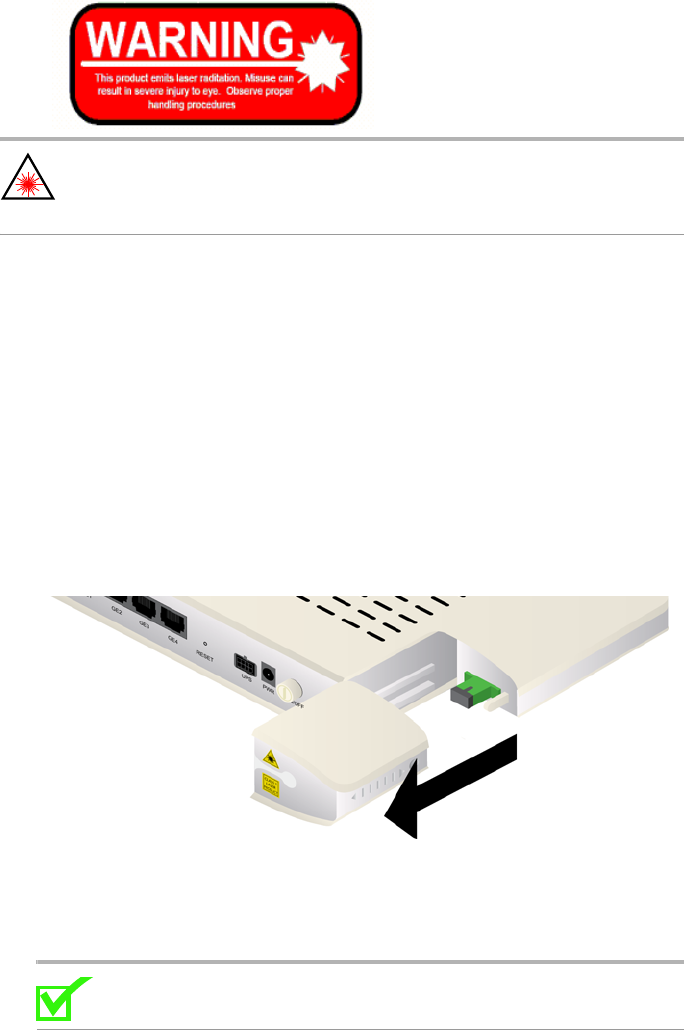
zNID 24xx Installation
40 zNID Hardware Installation Guide
Connect to network
Connecting the SC connectors
Connect the SC connector from the electronics module to the SC connector in
the zNID enclosure.
Observe the necessary precautions to decrease the risk of exposure to laser radiation.
WARNING! Risk of eye damage. At all times when handling
optical fibers, follow the safety procedures recommended by your
company.
Although Zhone optical products have a Class I certification, hazardous
exposure to laser radiation can occur when fibers are connected, disconnected
or broken. Handling of optical fibers without dust caps increases the risk of
exposure. Exposure to either visible or invisible laser light can damage your
eyes under certain conditions.
1Remove the fiber service cover by removing the fiber service screw and
then sliding the fiber service cover forward (toward the connection panel
of the 2424).
Using your thumb push on the raised marking on the fiber service cover to
slide it off.
For a new unit the fiber service cover will be in a bag, so you will not
need to do this step.
2Remove the dust covers from the SC/APC optical connectors. Clean the
connector if necessary.
3Plug in the fiber connector to connect the 2424 to the network.
Note: To function properly the optical strength to the zNID
should be between -8dBm and -27dBm
4Reattach the fiber service cover onto the zNID including the fiber service screw.
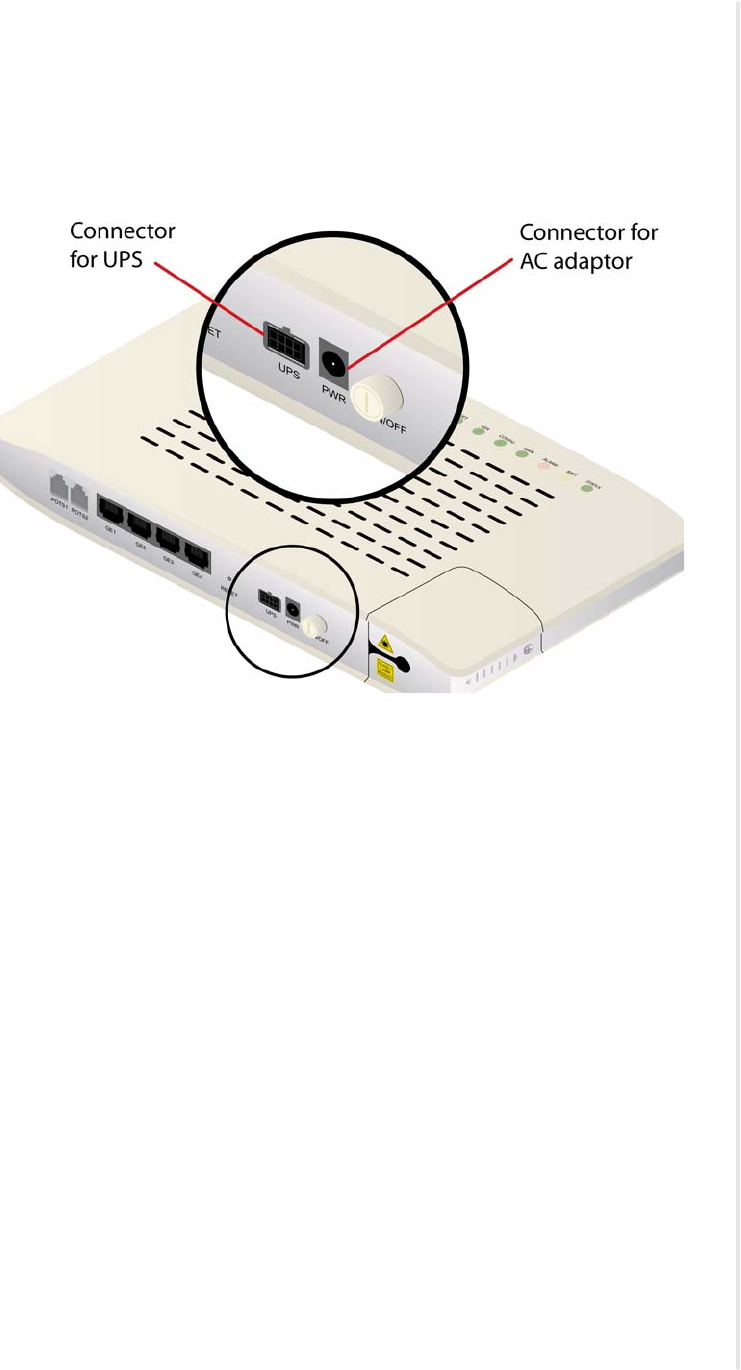
Connect to network
zNID Hardware Installation Guide 41
Connect power
The zNID is powered by AC power using the adapter which is shipped with
the unit. An optional uninterruptable power supply may also be used.
Figure 11: The zNID 24xx has both AC input and UPS input for power
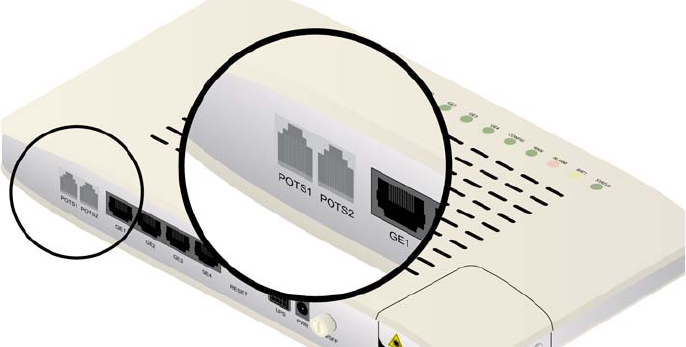
zNID 24xx Installation
42 zNID Hardware Installation Guide
Connecting phone terminals
The zNID 24xx models have the ability to connect POTS via RJ-11.
Connecting POTS
The zNID 24xx models have the ability to connect POTS via RJ-11 connector.
The terminal connections are shown in Figure 12.
1Locate the subscriber’s telephone wire pair.
Figure 12: Connect phone lines
2If the wire pair is not terminated, follow local practices to attach an RJ-11
connector.
3Plug the wire pair with RJ-11 connector into one of the 2424 RJ-11 phone
jacks.
4Repeat steps 1-3 as needed to connect additional phone lines.
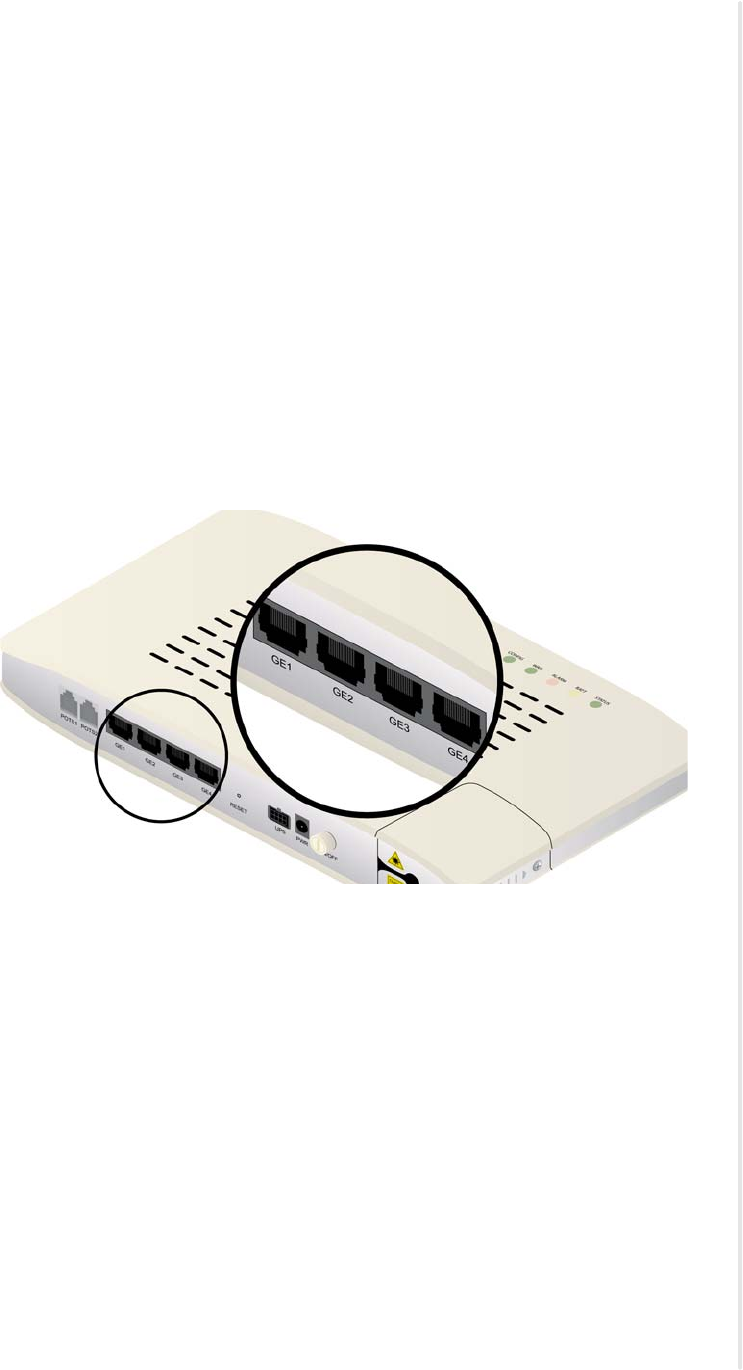
Connect to network
zNID Hardware Installation Guide 43
Connecting Ethernet ports
The zNID-24xx series models have up to 4 Gigabit Ethernet ports.
Connect Ethernet ports
The zNID provides RJ 45s for Ethernet connections. Ethernet connections can
be used to deliver any packet services including IPTV, data, and VoIP.
For Ethernet services, connect a Category 5 or a Category 6 cable to an RJ45
interface as shown in Figure 13.
1Locate the premises’ Ethernet LAN cable.
2If the cable is not terminated, follow local practices to attach an RJ-45
connector.
3Plug the Ethernet cable into the appropriate RJ-45 Ethernet port.
Figure 13: The RJ-45 Ethernet ports.
4Repeat steps 1-3 as needed to connect additional Ethernet cables.
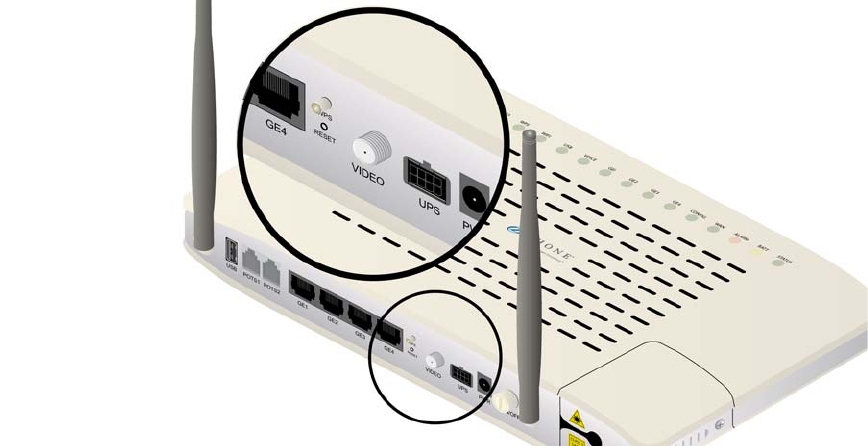
zNID 24xx Installation
44 zNID Hardware Installation Guide
Connecting coaxial port
The zNID-24xx series models have a coaxial port for RF video.
Connect coaxial port
The zNID provides a coaxial port for RF Video.
1Locate the premises’ coaxial cable.
2Screw the coaxial connector into the coaxial connector.
Figure 14: The coaxial port.
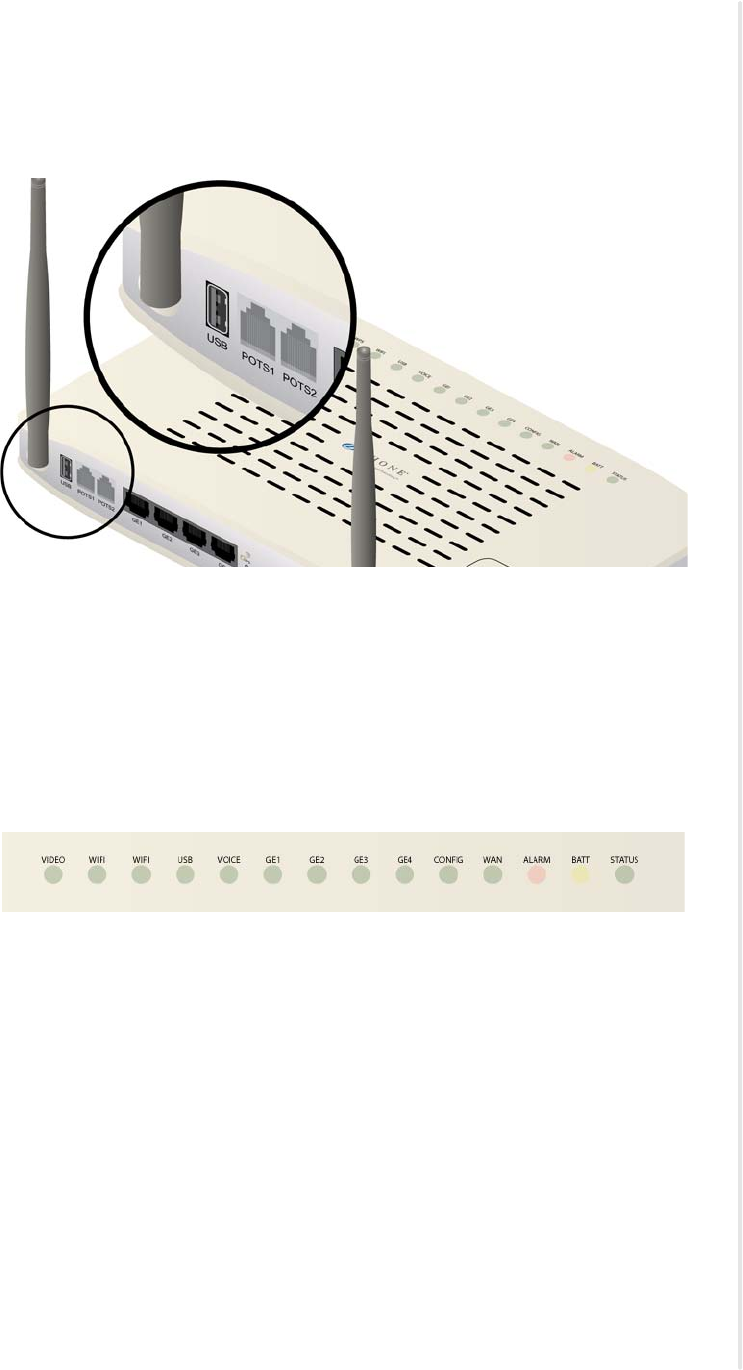
Connect to network
zNID Hardware Installation Guide 45
Connecting USB port
The zNID-24xx series models have a USB 2.0 port for USB storage server.
Figure 15: The USB port.
Complete the zNID installation
After making the physical connections, complete the installation by checking
the LEDs, the grounding for the full enclosure, closing the outer cover, sealing
the entry holes, and screwing in the final screw to secure the unit.
Checking the LEDs
Check the LEDs to verify that power is working.
See the zNID 24xx series LEDs on page 27.
zNID 24xx Installation
46 zNID Hardware Installation Guide
Index
48 zNID Hardware Installation Guide
